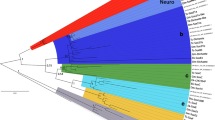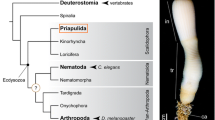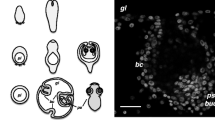Abstract.
Neochildia fusca is a member of the taxon Acoela, a group of flatworms that, according to some recent molecular phylogenetic analyses, are distinct from other flatworms and constitute a basal branch with a sister taxon relationship to the rest of the Bilateria. In this paper, we analyze early neural development in this species and report the sequence and expression of two Pit-Oct-Unc (POU) genes, NeocBrn-1 and NeocBrn-3. Homologs of these highly conserved genes play a role in neural fate determination in vertebrates, Drosophila and Caenorhabditis elegans. Acoels, including Neochildia, have a unique invariant pattern of early cleavage called duet spiral cleavage. In subsequent cell divisions descendants of the first three micromere duets form an outer layer of epidermal and neural progenitors surrounding the meso/endoderm progenitors, which are themselves descended from the macromere duet 4A, B and the micromere duet 4a, b. Organ formation begins at mid-embryonic stages with the epidermal primordium adopting a ciliated epithelial shape. Sub-epidermally, a bilaterally symmetric brain primordium can be seen at the anterior pole. Laterally and posteriorly, myoblasts form a thin layer underneath the epidermis. In late embryos and juveniles of Neochildia, the brain is formed by a 3–4 cell-diameter-thick layer of neurons forming a cortex surrounding a neuropile that is relatively free of cell bodies. A highly regular "orthogonal" array of muscle fibers penetrates the brain. We have isolated and partially sequenced homologs of the vertebrate Brn-1 and Brn-3 genes, which we call NeocBrn-1 and NeocBrn-3, respectively. These sequences contain and span portions of the POU-specific domain and a homeodomain, and are sequence similar to their respective homologs in vertebrates and Drosophila. RT-PCR reveals that NeocBrn-1 and NeocBrn-3 are expressed from mid-embryonic to adult stages. Whole-mount in situ hybridization shows expression of both genes in distinct subsets of nerve cells in juvenile and adult worms. NeocBrn-1 also appears in a subset of intra-epidermal gland cells. These observations are an initial step towards reconstructing the neural development of a key group of bilaterians, the Acoela. These flatworms, by virtue of their distinct morphology, development and phylogenetically basal placement, are likely to provide key insights into the interpretation of the evolution of metazoan neural architecture.
Similar content being viewed by others
Author information
Authors and Affiliations
Additional information
Electronic Publication
Rights and permissions
About this article
Cite this article
Ramachandra, N.B., Gates, R.D., Ladurner, P. et al. Embryonic development in the primitive bilaterian Neochildia fusca: normal morphogenesis and isolation of POU genes Brn-1 and Brn-3 . Dev Genes Evol 212, 55–69 (2002). https://doi.org/10.1007/s00427-001-0207-y
Received:
Accepted:
Issue Date:
DOI: https://doi.org/10.1007/s00427-001-0207-y




